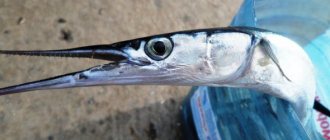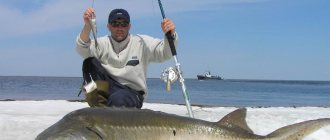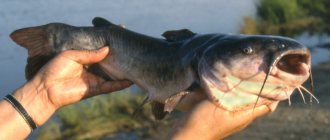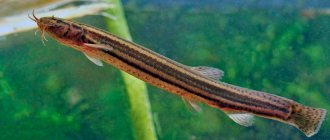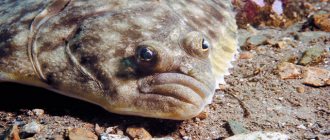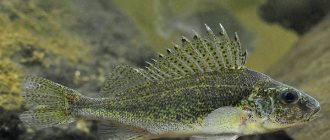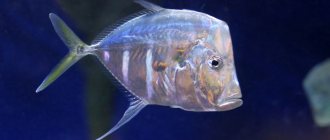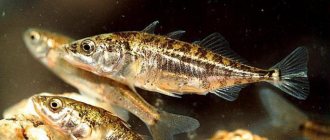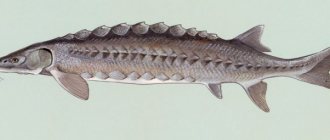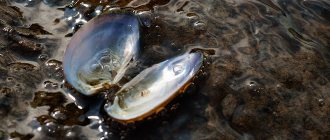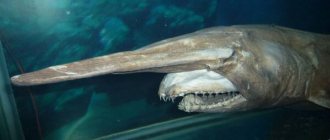Folk names
The saberfish looks so unusual and stands out from other fish, especially freshwater ones, that it has received a huge number of “alternative” names. Here are the most popular ones:
- side;
- sidewall;
- kasturya;
- mower;
- oseledets;
- saber;
- saber;
- cleaver
- chukhna;
- scratch;
- chuhon.
Photo: sabrefish
There are other local names that are less common. For example, in Belarus it is called “river herring” and “saber fish”. The fish received such “nicknames” because of its body shape and other features unique to it.
But its main name is still “chekhon”.
It, according to some linguists, comes from the word “scale”, since the outer cover of a fish easily falls off at the slightest mechanical impact from the outside.
Photo: sabrefish
There are other versions about the name of the fish:
- it is assumed that the words “chesha” and “chekhon” come from the verbs “hew”, “comb”, in which the alternation of consonants “t/ch”, “w/x” occurred;
- or that the word “chekhon” has the same root as the noun “pig,” which in colloquial speech means “piglet, young pig.”
Preparing the fish
It is recommended to use freshly caught fish, then the result will be not only aromatic, but also preserved all the delights of the taste of saberfish. You can smoke fish whole or flat, cleaned or not.
Clean and plaster
We follow the following procedure for preparing fish:
- We gut the carcasses. We carry out this operation by cutting the abdomen extremely carefully. Otherwise, the integrity of the gallbladder can be damaged, and this threatens to leak bile into the meat, which will give it bitterness and make it inedible. You will have to rinse it for a long time and thoroughly.
- We wash the carcasses thoroughly. To do this, we use cold water and napkins, which we use to dry the abdomen after removing the film and blood clots. We remove the fins: caudal and anal.
- We flatten large carcasses using a knife. We cut along the spine, cutting the rib bones and dividing the carcass into two parts. The head is also cut, if it remains.
- Remove bones and gills. It is necessary to remove the ribs and ridge, as well as the gills - this will contribute to better preservation of the product.
It is not recommended to smoke ungutted sabrefish, as it will have an unpleasant odor and a bitter taste.
Salting methods
Before smoking, salt is used to remove excess moisture. To salt sabrefish, one of two methods is used:
- dry;
- wet.
Dry pickling. Rub medium-fine salt (150 g of salt per 1 kg of fish) into the walls of the peritoneum and pour into the gills. The fish is placed tightly in a container that does not oxidize (a wooden box or basket with a lined bottom). The fish is sprinkled with salt between the rows and on top by about 10 mm. There should be a pressure on top of the semi-finished products, which with its weight will squeeze the juice out of the fish, and it will flow through the bars of the basket. Normal salting requires at least 24 hours and a temperature within 2-4°C degrees. To give better taste to the salt, you can add black pepper, garlic, and ginger.
Expert opinion
Dmitriev Roman Igorevich
Knowledgeable about smoking products.
For better salting, carcasses should be laid belly up.
Wet Ambassador. For those who are doing salting for the first time, this option is the most acceptable:
- Place the fish, belly side up, in a container (you can use large pots, buckets or basins) in tight rows.
- Sprinkle with salt and sugar (1 kg of sugar per 1 kg of salt), per 1 kg of fish you need 100 g of the mixture.
- Place a weight on top.
The fish will be salted in the secreted juice for 2-3 days. Choose a cool place for storage.
The following wet salting method is also used:
- Pre-boil the brine mixture in a 10 to 1 ratio of water and salt. For taste and smell, add black and red pepper, garlic, bay leaf.
- Cool and dip the saberfish prepared for salting into the brine.
- They are pressed on top with something massive and kept in the refrigerator for 2-3 days. From time to time the raw materials are turned over.
Soaking and drying
To prevent salt from appearing on the fish during smoking, it should be rinsed with cold running water after salting. If the sabrefish turns out to be too salty, the procedure is carried out within 3 hours. If stagnant water is used, it is changed regularly - at least 5 times. After soaking is completed, the carcasses are dried using napkins.
Before smoking, the fish is dried to remove residual moisture. Covering it with gauze to prevent dust, mosquitoes and flies, hang it by a wire through the eyes. For better wilting, you can insert sticks as spacers.
The drying procedure, depending on the size of the carcasses, takes from 12 to 24 hours. It is necessary to monitor the process so that less sunlight falls on the fish and it is easily ventilated.
Do not allow the fish to dry out, otherwise you will have to soak it again for a while.
What does a saberfish look like?
The body of the sabrefish is saber-shaped, long and narrow. The dorsal line is straight. However, the lower part of the body is convex, arched, bordered by a leathery, scaleless keel. The outline of the head resembles a small scoop, in the upper part of which there are relatively large eyes and a large mouth with thin hooked teeth.
Chekhon - external appearance
Almost the entire body of the fish is covered with small scales of a silver-shiny color, the back is greenish-dark. The fins are yellow and gray: the dorsal and caudal ones are gray, the rest are more yellow. Color may vary depending on where the individual lives.
In addition, the fins vary in length and shape. The dorsal is short, its location is close to the tail. The caudal fin has a large notch. The circumanal fins are long, ray-shaped, but the pectoral fins are longer than all the others except the caudal one. In this regard, sabrefish are to some extent reminiscent of sea flying fish from the order Garfish.
The lateral line of sabrefish is zigzag-shaped, sharply descending from the upper gill cover.
Enemies
Good observation and natural flexibility allow Chekhoni to avoid danger in the water, but the risk factor is present on the surface. When fish jump out of the water to grab an insect, they unwittingly become food for seabirds. Adults are sneaky enough to get away from pike perch and pike, but inexperienced juveniles can become food for large predatory fish. Troubles for fish are caused by parasites with which they can be infected, but the main enemy of the Chekhon fish is humans. The population of the species is sharply declining due to barbaric hunting, which continues, even despite the tightening of measures against poachers.
This is interesting: Chekhoni has large eyes with good visibility; thanks to this feature, she always controls her surroundings and it is difficult to get close to her unnoticed.
Where is the saberfish found?
Chekhon is a fish adapted to life in water with varying temperatures and salinity and is considered a semi-anadromous freshwater species. This aquatic inhabitant's body easily adapts to environmental conditions.
Osmoregulation (the system for regulating salt balance) successfully rebuilds internal organs for life from fresh water to salty sea water. Fish also quickly adapt to different water pressures.
The saber fish avoids only places with unclean water contaminated with all kinds of industrial and household waste.
Fish recipes
Before cooking, sabrefish are cleaned of intestines and gills are removed. After processing, it is fried or stewed. The Chinese prepare this fish only for the New Year holidays; the dish is considered an excellent snack. In other countries, they are used to eating it dried or salted. After the drying process, fish meat is saturated with spicy taste and aroma. Great for low alcohol drinks.
Before salting, the entrails are removed from the fish. Place in a solution with salt and press down with a weight. Leave for a day in a cool place. The salting time depends primarily on the weight of the product.
Baked sabre. The fish is cleaned, seasoned with salt, rice wine and black peas. They marinate for several hours, and then add the tomato and mustard. Salted vegetables are used as a garnish. The saber can also be deep-fried: to do this, it is fried until crispy and simmered in a frying pan, adding ginger and garlic.
Schnitzel from the carp family is a very tasty and unforgettable dish. To prepare it you need:
- A kilogram of sabrefish.
- Dill.
- Leek.
- Eggs.
- Milk.
- Flour.
- Salt.
- Pepper.
The fish is cleaned, the spine, ribs, head and tail are removed. The fillet halves are not cut on the back, they are left whole. Wash thoroughly in water and dry. Sprinkle flour on the table, add salt and place half a fillet in the resulting mixture, skin side down.
The inside is sprinkled with salt, pepper, dill and onion. Greens can be replaced with tomato paste and grated cheese. Cover one half with the other half so that the skin remains on the outside. Sprinkle the outer part with flour and fry both sides in a frying pan in vegetable oil until crispy and golden brown.
TOP 5 wobblers for perch
Burbot: DESCRIPTION, REPRODUCTION, HABITAT, FOOD, PHOTO, VIDEO, POPULATION
PIKE: SPECIES, REPRODUCTION, FOOD, SIZE, ORIGIN, PHOTO, VIDEO, DESCRIPTION
Tench: SPECIES, DESCRIPTION, REPRODUCE, BEHAVIOR, NUTRITION, PHOTO, VIDEO, ORIGIN
CRUCCIAN: SPECIES, DESCRIPTION, FOOD, REPRODUCE, PHOTO, VIDEO, POPULATION, BEHAVIOR
ROACH: DESCRIPTION, SPAWNING, LIFESTYLE, FOOD, PHOTO.
Types of saberfish
Although this is a semi-anadromous species that has learned to live successfully in both salt and fresh water, there are fish colonies with a permanent habitat (sedentary), which differ from semi-anadromous ones in their darker back color and growth rate. Sedentary animals, as a rule, gain weight more slowly. But both of them spawn only in fresh waters.
Photo: sabrefish
Is it crucian carp or not?
Many amateurs confuse Chekhon with Karas and they can’t be understood. Few people know what a real Kosar looks like and there is a distant similarity between these fish. The river variety of crucian carp is the same silver color, and they differ from their closest relatives in that they have a more elongated body with a narrow belly, almost like Sablyanitsa. Another similarity is felt in the taste and nutritional value of low-calorie meat. What they also have in common is that the fillet literally consists of small bones, so these fish are preferably consumed dried, dried and smoked. If you want to try it fried or baked, then you need to make oblique cuts along the back on both sides of the carcass. The crushed bones will be crushed and will not disturb the oral cavity. These biological representatives of cyprinids are also separated by different habitats. Maneuverable, freedom-loving Mowers prefer water without excessive vegetation, while the slower and clumsier Karasik likes to hide in the bushes. In terms of life expectancy, the second representative of cyprinids wins, which is very tenacious, unpretentious, feels great in dirty reservoirs and sometimes lives up to 15 years. The fast-moving Chekhon is more fastidious, capricious, loves clean water without harmful impurities and rarely reaches the age of 6-7 years.
Conclusion: An experienced fisherman will never confuse these two species and will say with confidence that Chekhon is far from Crucian carp. It is enough to compare the eyes of fish: in the first they are large and expressive, in the second they are small and inconspicuous.
Habits and lifestyle
Both the semi-anadromous and sedentary species of sabrefish equally prefer to spend most of the day in those areas where there is a sufficient food supply. They find clean places with little bottom vegetation and complex bottom topography - where there are natural shelters, riffles and holes. Flocks take refuge in pits, spend the night, and spend the winter months.
Chekhon is especially active all day long, from morning until early evening dawn. At this time, she feeds on fry, all kinds of invertebrates and insects.
The sabrefish is a cautious fish - it is careful not to approach the coastal edge and shallow water during daylight hours. Only at a depth of five to six meters does she feel safe.
However, in the process of eating, the saber fish often gives itself away, makes noise, jumping out of the water. Apparently, appetite and the excitement of the hunt overcome caution in her.
Habitats and environment of saberfish
Saber fish spend most of their time in deep, open water. In summer it rises from the depths in search of food. It can definitely be found in places with strong currents and whirlpools. Less often, it is almost impossible to find it near the coastline.
Schools of this fish are mainly found in vast reaches and rapids.
Chekhon has chosen the waters of the southern regions of Russia, reservoirs flowing into:
- to Baltic;
- Black;
- Caspian;
- and the Sea of Azov.
The fish prefers flowing rivers and clean reservoirs to muddy standing water. It is almost impossible to find it on small rivers. In winter, saberfish, gathering in schools of 10-20 individuals, prefer quiet water. In favorable, calm weather, you can observe the movement of fish from one place to another. When the weather is uncomfortable: windy or severe frost, flocks of silvery beauties crowd tightly into one place.
Chekhon spawning
The saber fish begins to spawn at a water temperature of about twelve degrees Celsius. Spawning begins no earlier than April and continues in different water areas until June. This period is characterized by a rise in the level of flood waters, which allows saber fish to move upstream over long distances to select suitable spawning sites.
Egg laying occurs at a depth of one to three meters in places with fast water flow. This choice is not accidental; for development, the offspring need a constant flow of oxygen, which they can only receive in flowing water. In this regard, even those flocks that lead a sedentary lifestyle, located in large artificial reservoirs, rise almost to the very sources of the rivers during the spawning period.
Females who have reached the age of five begin to spawn, then more mature individuals join this process.
The caviar egg, the size of which is from two to two and a half centimeters, is of the pelagic type (located in the water column). Getting into the water and being fertilized, it floats on its surface, gradually absorbing moisture and increasing in size. Before the larvae hatch from it, the size doubles. This transformation usually occurs within a week depending on the ambient temperature.
The hatched fry feed on substances from the yolk sac located in their esophagus for several days, and then switch to external nutrition.
Flocking together in flocks, they move downstream. Feeding on zooplankton, in a year they grow up to 7 centimeters in length, and by three years – up to 25 or more centimeters.
The survival rate of sabrefish fry is quite high. This occurs due to the speed of movement of the fry in the aquatic environment and careful behavior.
What does it eat?
The diet of sabrefish consists of:
- zooplankton;
- insects and their larvae;
- invertebrates living in a body of water.
During the period of activity, this fish grabs everything that at least roughly resembles food.
A piece of white foam rubber is suitable to imitate maggots, and red thread from a potato net is a good substitute for bloodworms.
The sabrefish, the photo of which you see, was caught using artificial bait.
Chekhon's appetite is excellent. She does not refuse fry, grasshoppers, dragonflies and their larvae. They catch it with a worm, and also with silicone baits - small twisters, preferably red, and even with wobblers.
The saber fish hunts fry in a unique way. At first, she does not show anything about her gastronomic interest - she does not attack from an ambush, does not chase after small change, but calmly joins the flock. Taking advantage of the opportunity, it grabs the fry and goes with it to the depths.
Population and species status
Chekhon is a collective fish that always lives together. The area of its settlement throughout Russia is huge, but its numbers are heterogeneous. In some regions there is a lot of it, in others it is on the verge of extinction.
- The northwestern region of our country stands out for its high population density: Lake Ilmen, Lake Onega, and Lake Ladoga.
- In the Moscow, Tver, Bryansk, Kaluga regions, as well as in the Northern Donets River, in the upper reaches of the Dnieper, its population is small.
Features of catching sabrefish
In permitted areas, catching sabrefish is possible after spawning and before winter cold, as long as the fish are active and have not left for the winter. Particularly productive periods are when the fish begin to eat and gather in huge schools. At this time, a decent catch is almost guaranteed to every fisherman.
Biting calendar
Seasons indicating the month when sabrefish bite best:
| Month: | Cool: | Notes: |
| January | weak | Rare bites, sabrefish in an inactive state. |
| February | absent | Inactive. |
| March | absent | The beginning of the spring flood, the fish will rise from the pits. |
| April | average | He wakes up and starts looking for food. |
| May | good | The first ten days of the month are spawning, by the end of the month there is active behavior and good bite. |
| June | good | Search for food. |
| July | good | Zhor, the fish is very active. |
| August | good | Activina before the rain. |
| September | average | It bites well on baits of animal origin. |
| October | average | It begins to bite closer to noon, after the water warms up. |
| November | absent | It sinks to the bottom, looking for a winter mooring site. |
| December | absent | It stays in holes and doesn’t take bait. |
How and what they catch
Chekhon is selective. It does not bite on every primaka.
- In the spring, it actively reacts to dung worms, bloodworms, caddis flies, and most readily to maggots.
- In summer, it is successfully caught using insects (blow flies, horse flies, horseflies, etc.), and large individuals can be tempted by live bait and artificial bait attached to a hook.
The following gear is used for catching sabrefish: rubber band; donka; float rod; feeder; spinning.
- An elastic band and a donka are appropriate in cases where there are a lot of fish in the water and they are active. You can catch several specimens at once in one cast.
- It is more convenient to fish with a feeder rod in shallow water or in cold weather when the fish are at depth.
- Float tackle is universal, inexpensive and simple, but it is better to have match or Bolognese fishing rods. They allow you to cast the bait further.
Where to catch saberfish
When choosing a place to catch sabrefish, do not forget that this is an anadromous fish. Its location changes at different times.
- Twice a year, in spring and autumn, saberfish migrate en masse. At this time, it needs to be caught near holes, on rifts, near snags and bushes.
- In summer, saberfish feed in clean areas not overgrown with aquatic vegetation, on the boundaries of fast and slow currents, on shallows and sand spits.
Commercial value of sabrefish fish
Chekhon is a valuable commercial fish species. Its commercial fishing usually occurs in the autumn - late August and September. The second period of commercial fishing is spring, from April to mid-June, when fish gather in large schools of up to hundreds of thousands of individuals for migration.
Chekhon fish are caught using nets called “sichel fish” by fishermen. These can be floating nets with floats or fixed ones, which are secured to the bottom with anchors. It is effective to catch sabrefish using nets using live bait - worms or insects. It happens that seines are used to catch this fish.
Some time ago, in Azov and in the Don River, saberfish had serious commercial significance. It was caught in tens of thousands of centners. But then production fell sharply.
Commercial fishing for sabrefish was carried out in the Caspian Sea, in the Kerch Strait, in the lower reaches of the Dnieper and rivers of the Black Sea basin, in Lake Ilmen.
Chekhon in cooking
In folk cooking, they have long learned to make real delicacies from “saber fish”. The most popular of them is dried and smoked sabre. In addition, sanitary fish is canned, pickled, salted, stewed, all kinds of soups are cooked from it, and cutlets and schnitzels are made from fish meat. It is also good simply fried with a potato or vegetable side dish.
Taste qualities
Chekhon meat is of medium fat content, sweetish in taste, with a characteristic aroma. The fillet structure is elastic and dense. Without heat treatment, in salted and dried form, the taste properties are more pronounced - the aroma is preserved, the seeds do not harden. After heat treatment, the specific aroma is less pronounced.
Dried chekhon
Chemical composition and KBZHU
Chekhon is a dietary low-calorie product with medium fat content. Contains many useful microelements.
Calories and nutritional value:
| Property: | Meaning: |
| Calorie content per 100 g. | 88 kcal |
| Squirrels | 17.5 gr. |
| Fats | 2 gr. |
Micro- and macroelements:
| Water | 70 |
| Chromium | 55 mcg |
| Fluorine | 430 mcg |
| Molybdenum | 4 mcg |
| Nickel | 6 mcg |
| Zinc | 0.7 mcg |
| Chlorine | 165 mcg |
Beneficial features
The chemical composition of the meat of this fish contains many minerals: chromium, fluorine, zinc, molybdenum, nickel, calcium, phosphorus. There is also a large amount of vitamin PP (nicotinic acid), which is necessary for many redox processes in our body, the formation of enzymes, and lipid-fat metabolism in living cells.
Nickel, fluorine and phosphorus, calcium form tooth enamel, nail plates, hair, and strengthen bones. Molybdenum has the ability to remove uric acids from our body. Including Czechs in your diet helps strengthen the nervous system.
The beneficial substances in the composition of saberfish help reduce blood sugar and cholesterol.
@YAYImages – depositphotos.com
This fish is contraindicated only if you are allergic to it. Smoked, salted and dried sabrefish should not be eaten by people with diseases of the urinary system and hypertension.
Fishermen give preference to the Azov and Caspian populations of Czech fish. Volzhskaya is smaller and the meat is leaner. The inhabitant of the Don is fatter and larger in size.
@Beaver1488 — depositphotos.com
